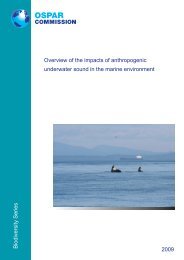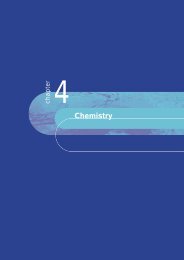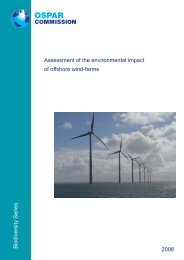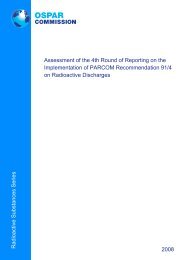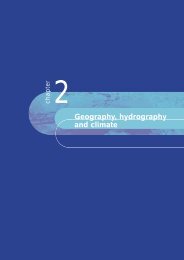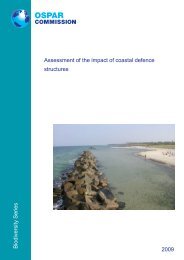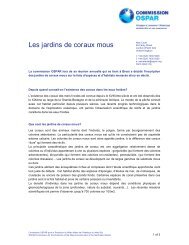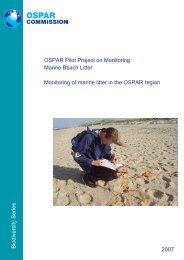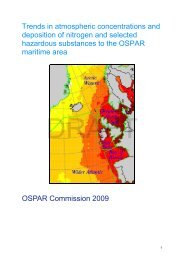Assessment of Modiolus modiolus beds in the OSPAR area Ivor ...
Assessment of Modiolus modiolus beds in the OSPAR area Ivor ...
Assessment of Modiolus modiolus beds in the OSPAR area Ivor ...
Create successful ePaper yourself
Turn your PDF publications into a flip-book with our unique Google optimized e-Paper software.
towed and static gear methods can also be reduced by this type <strong>of</strong> restrictive zon<strong>in</strong>g. Static gears (long-l<strong>in</strong>es,<br />
set nets and traps) have comparatively little impact on <strong>the</strong> fundamental structure <strong>of</strong> <strong>Modiolus</strong> <strong>beds</strong> so <strong>the</strong>re<br />
can be conservation and ecosystem benefits from local zon<strong>in</strong>g. However, where <strong>the</strong> rotational closures have<br />
been proposed for some scallop fisheries, <strong>the</strong>se would probably not conserve <strong>Modiolus</strong> <strong>beds</strong>, because<br />
recovery times are far too long. Seasonal closures would be even less effective. Such matters fall primarily<br />
with<strong>in</strong> <strong>the</strong> remit <strong>of</strong> fisheries organisations but <strong>OSPAR</strong> can <strong>of</strong>fer op<strong>in</strong>ions especially where ecosystem-based<br />
fisheries management <strong>in</strong>terfaces with <strong>the</strong> <strong>OSPAR</strong> remit on species and habitat protection.<br />
Data on <strong>the</strong> <strong>in</strong>tensity <strong>of</strong> fish<strong>in</strong>g, both spatially and by gear types is based on log book returns, on patrol<br />
vessel or aircraft surveillance and <strong>in</strong>creas<strong>in</strong>gly on GPS l<strong>in</strong>ked Vessel Monitor<strong>in</strong>g Systems (VMS). The later<br />
report vessel positions to national authorities via satellite l<strong>in</strong>ks. Compliance with <strong>area</strong> closures and some<br />
o<strong>the</strong>r management measures depends partly on such records. There are particular problems <strong>in</strong> reliance on<br />
VMS to monitor <strong>the</strong> co<strong>in</strong>cidence <strong>of</strong> scallop dredgers with <strong>Modiolus</strong> <strong>beds</strong>. Some dredg<strong>in</strong>g is done by vessels<br />
below <strong>the</strong> size where VMS is mandatory. More importantly, VMS only logs vessel positions at regularlyspaced<br />
<strong>in</strong>tervals, but <strong>Modiolus</strong> <strong>beds</strong> tend to occur patchily at much smaller scales than <strong>the</strong> distances vessels<br />
can tow between positions be<strong>in</strong>g recorded. Unless buffer zones around protected <strong>area</strong>s for <strong>Modiolus</strong> <strong>beds</strong> are<br />
large, it is possible for a vessel to significantly <strong>in</strong>fr<strong>in</strong>ge on a feature and go clear aga<strong>in</strong> dur<strong>in</strong>g <strong>the</strong> <strong>in</strong>terval<br />
between positions be<strong>in</strong>g recorded. To aid compliance this weakness could be overcome by <strong>in</strong>troduc<strong>in</strong>g some<br />
extra position record<strong>in</strong>g at randomised unpredictable <strong>in</strong>tervals. Where limited numbers <strong>of</strong> vessels are<br />
licensed to dredge near protected habitats <strong>in</strong> some coastal waters, mobile telephone ra<strong>the</strong>r than satellite l<strong>in</strong>ks<br />
could permit positions to be logged more frequently at lower cost. Alternatively <strong>the</strong> more precise “black<br />
box” record<strong>in</strong>g systems used to manage aggregate dredg<strong>in</strong>g could be adapted.<br />
Requirements for Impact <strong>Assessment</strong>s and or habitat surveys when major <strong>in</strong>frastructure developments are<br />
planned will <strong>of</strong>ten serve to make extra <strong>in</strong>formation available on <strong>the</strong> location and extent <strong>of</strong> any biogenic<br />
reefs. Sometimes pipel<strong>in</strong>e or cable routes can <strong>the</strong>n be chosen to avoid particularly sensitive features.<br />
Environmental monitor<strong>in</strong>g <strong>of</strong> major <strong>in</strong>frastructure developments has <strong>of</strong>ten helped provide long-term data<br />
not easily obta<strong>in</strong>ed by o<strong>the</strong>r means, particularly on <strong>the</strong> re-colonisation <strong>of</strong> disturbed <strong>area</strong>s.<br />
6. Conclusion on overall status<br />
As <strong>Modiolus</strong> <strong>modiolus</strong> can be found liv<strong>in</strong>g <strong>in</strong>dividually <strong>in</strong> benthic habitats, as well as form<strong>in</strong>g aggregations,<br />
where it is <strong>the</strong> key species structur<strong>in</strong>g a biogenic habitat. Def<strong>in</strong><strong>in</strong>g what should be classified as <strong>Modiolus</strong> bed<br />
is seldom absolute. The <strong>beds</strong> tend to occur as quite small features that are <strong>of</strong>ten patchy. It is difficult to<br />
predict precisely where <strong>beds</strong> occur, to def<strong>in</strong>e <strong>the</strong> limits <strong>of</strong> particular <strong>beds</strong> or to measure <strong>the</strong> extent <strong>of</strong> <strong>the</strong><br />
habitat. While some <strong>beds</strong> are well known, even <strong>in</strong> <strong>area</strong>s where <strong>the</strong> distribution <strong>of</strong> coarse-scale benthic<br />
habitats is well understood, previously unknown small <strong>beds</strong> <strong>of</strong> <strong>Modiolus</strong> cont<strong>in</strong>ue to be found. Although<br />
several maps have been produced both for countries and regions, <strong>the</strong>re are considerable uncerta<strong>in</strong>ties over<br />
<strong>the</strong> current distribution <strong>of</strong> <strong>the</strong> habitat. In particular, some maps have shown stations as <strong>beds</strong> where only spat-<br />
<strong>OSPAR</strong> Commission<br />
DRAFT<br />
sized mussels were found <strong>in</strong> grab samples. Some Contract<strong>in</strong>g Parties have surveys <strong>in</strong> progress, us<strong>in</strong>g multi-<br />
beam acoustic techniques, to derive habitat maps <strong>of</strong> <strong>the</strong> whole <strong>of</strong> <strong>the</strong>ir waters, while o<strong>the</strong>rs are undertak<strong>in</strong>g<br />
targeted surveys <strong>of</strong> sensitive habitats. At <strong>the</strong> present time it is thus premature to put much reliance on sea<br />
<strong>area</strong> scale maps <strong>of</strong> <strong>the</strong> <strong>Modiolus</strong> bed habitat. However, s<strong>in</strong>ce <strong>the</strong>y can <strong>of</strong>ten be discrim<strong>in</strong>ated by<br />
comb<strong>in</strong>ations <strong>of</strong> <strong>the</strong> sonar and remote camera methods that are now rout<strong>in</strong>ely employed, it is anticipated that<br />
better <strong>in</strong>formation will be available with<strong>in</strong> 5 years.<br />
As ecological features <strong>the</strong>re is good evidence that:-<br />
• <strong>Modiolus</strong> <strong>beds</strong> have a role <strong>in</strong> benthic productivity which is disproportionate to <strong>the</strong>ir extent, have high<br />
biodiversity and may be locally important <strong>in</strong> provid<strong>in</strong>g both refugia and feed<strong>in</strong>g opportunities for<br />
young fish.<br />
• Although <strong>in</strong>dividual large mussels are relatively resistant to mechanical damage, disturbance to bed<br />
structures and breakages by heavy fish<strong>in</strong>g gear is <strong>the</strong> most significant anthropogenic threat to <strong>the</strong>se<br />
features. Repeated disturbance can elim<strong>in</strong>ate <strong>beds</strong> entirely.<br />
Nom<strong>in</strong>ation <strong>of</strong> <strong>Modiolus</strong> <strong>modiolus</strong> <strong>beds</strong> to be placed on <strong>the</strong> <strong>OSPAR</strong> List was on <strong>the</strong> basis <strong>of</strong> an evaluation <strong>of</strong><br />
<strong>the</strong>ir status accord<strong>in</strong>g to <strong>the</strong> Criteria for <strong>the</strong> Texel-Faial Criteria (<strong>OSPAR</strong> 2003). The citation noted <strong>the</strong><br />
9<strong>of</strong> 22



